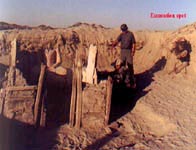The temple reveals the origin of Buddhism in China
 Archaeologists have discovered a temple dating back more than 1,500 years, at the edge of the Taklimakan desert, in the northwest of the Xinjiang autonomous region of China.
Archaeologists have discovered a temple dating back more than 1,500 years, at the edge of the Taklimakan desert, in the northwest of the Xinjiang autonomous region of China.
The temple is named Tuopulukedun 2.25 m high, 2 m wide, with a wall about 1.3 m high. The temple is made of wood, mud and has paintings depicting Mahayana on four walls. A 0.65 m Buddha statue is located in the center of the temple. Located in the north are Buddha statues with wide shoulders and small waist.
To date, this temple is considered to be the smallest ever discovered in the world, said Wu Xinhua, at the Chinese Institute of Archeology. " It is also the only ancient temple in the Taklimakan desert that is relatively intact with a clear mural on the wall ," Wu said.
About 3,000 years ago, the Yutian kingdom was born on the southern edge of the Taklimakan Desert - the largest desert in China and the second largest in the world . Buddhism was brought into the Yutian kingdom from that time.
The Yuchi family, which began to reign over Yutian about 2,000 years ago, were deeply religious and tried to promote this tradition by building many temples. Since then the Mahayana sect has also been introduced into inland China.

Part of the painting on the wall
In the middle of the 8th century, the Kalahan kingdom in the Taklimakan desert launched a religious war against Yutian and defeated the dynasty in 1006. Since then, Islam has been brought into the throne. onions. Many temples built during the Yutian period have been destroyed for over 1,000 years.
Tuopulukedun temple was buried in sand for about 1,500 years and recently discovered by a cowboy. Archaeologists at the Chinese Academy of Social Sciences excavated the area within a radius of 100 meters around the temple from September 30 to October 12 this year, but found no other valuable relics.
Tuopulukedun Temple opened a door for archaeologists to study the ancient Yutian dynasty. The shape, temple structure, murals on the walls and other relics also have important value in studying the Buddhism and mural art of the Yutian dynasty, as well as the development of Buddhism in the Northwest. China and in mainland China.
The temple is also evidence of East-West cultural exchange on the Silk Road, an important trading hub linking China with Asia for more than 2,000 years.
500 m to the west of the temple is a 30 m wide ditch running in the direction of North North. The area along the ditch used to be the center of the Bimo kingdom, a small dynasty built on an oasis, then occupied by the Yutian family. The ditch is called Damagou by locals. Wu said the name Damagou actually originated from Sanskrit, meaning " Tank containing Buddha's lectures ".
Archaeologists also discovered a large amount of relics around Damagou area that corroborated the history of the Yutian dynasty and the history of southern Xinjiang.
MT ( according to Xinhua News Agency )
- Robot monk introduces Buddhism
- Discover the greatest Buddhist wonder in the world
- The remains of Shakyamuni Buddha in thousands of years in China?
- See the wonders of Buddhism on the legendary Silk Road
- Discovering a huge 3,000-year-old Sun temple in China
- Sun Temple Konark, Orissa - India
- Wat Rong Khun - a pure white Buddhist wonder like a fairy
- Mystery of temples 'timeless' in India: There is a value of up to 100 billion USD!
- Horyu-ji temple's Buddhist architectural complex
- Detecting traces of origin forming groundwater on the surface of Mars
- The origin, meaning of Buddha's Birthday and rituals should be done on the sacred day
- Ajanta cave temple - India
 Discovered an ancient centipede fossil 99 million years old
Discovered an ancient centipede fossil 99 million years old Discovered bat-like dinosaurs in China
Discovered bat-like dinosaurs in China Discovered a 200-year-old bronze cannon of the coast
Discovered a 200-year-old bronze cannon of the coast Discover 305 million-year-old spider fossils
Discover 305 million-year-old spider fossils